|
SPECIAL HAPPENINGS
SAVE THIS DATE: SEPTEMBER 16, 2007 – FFBC ANNUAL PICNIC
You have probably seen references and heard the buzz about FFBC's upcoming picnic.
Details are:
DATE: Sunday, September 16
WHERE: Ed Levin’s Oak Knoll Location (Just past Downey traveling East on Calaveras)
TIME FOR LUNCH: 1:00 PM
WHO: All FFBC current club members
MENU: Catered by Armadillo Willy's
PRICE: $5.00/person
We need an accurate count for the caterers no later than September 09. Any FFBC Board member will be available to collect your $5 fee to hold your reservation during or prior to the September club meeting.
Please note: there will be an additional fee (I believe it is $6) collected by Ed Levin Park if you plan to arrive via automobile. At least one club ride will be leaving from downtown Niles and cycling to the Park. (Details will be available in September’s Ride Schedule.)
Don't miss this wonderful opportunity to spend quality cycling time with your FFBC cycling buddies before enjoying a wonderful meal catered by Amarillo Willy's.
Looking forward to seeing you in Ed Levin Park on September 16.
Your truly,
FFBC Board
Bicycle Blunders and Smarter Solutions
by Fred Oswald, LCI #947
5. Blunders in Planning & Engineering
The Door Zone (continued)
Diagram with distorted vehicle sizes [7]
|
Installing striped bike lanes next to parked vehicles is, at best, a bad practice. If it is done anyway, the space required for parking space and bike lane combined is eighteen feet (see diagram below). The Chicago and Cambridge installations allow only about twelve feet, the minimum that meets AASHTO Guide standards. Other plans have been even worse. A proposed bike lane in Austin Texas would allow only 10 feet including the parking area.
Some cities combine a parking lane with a bike lane. This not only leads to riding in the door zone, it also encourages the dangerous practice of cyclists weaving in and out between parked cars. This "peek-a-boo" riding style can easily lead to collisions.
For more information about bicycle operation next to parked vehicles, including a unique idea of using "parking crosses" to mark a door zone buffer, see the article Bicycling and On-Street Parallel Parking. The parking crosses (also shown in the diagram below) improve safety by discouraging door zone operation. They also encourage motorists to park within the parking lane. However, even if adequate space is provided, a bike lane stripe creates the intrinsic hazards described above. Better alternatives are described in part 9 of this series.
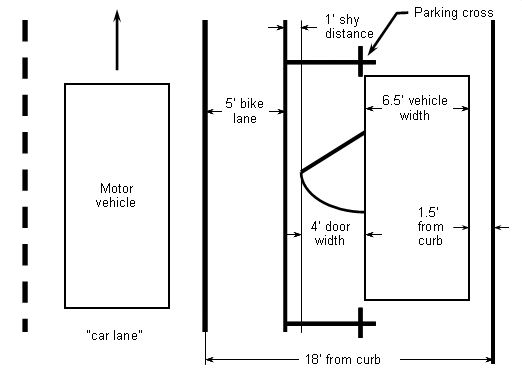 Space req'd for bikelane and parking lane Space req'd for bikelane and parking lane |
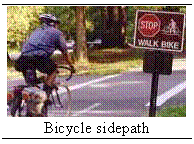 Even More Dangerous Bicycle Facilities Even More Dangerous Bicycle Facilities
Generally the most dangerous bicycle facility is a sidepath (a path beside the roadway). Such a path is essentially an asphalt sidewalk and it presents the user with the dangers of riding on sidewalks: a potential crash scene at every road crossing and at every driveway. Note the sign in the photo at right that instructs the cyclist to walk his bike (across a driveway leading to a picnic area). There is no stop sign for traffic on the road in the background, nor are motorists asked to push their vehicles through any intersection. This author estimates that less than one cyclist in 1000 stops at the sign. Its purpose is apparently to deter lawsuits (blame crash victims).
Riding on sidewalks and paths also introduces conflicts with pedestrians. Pedestrians are much more maneuverable than cyclists. They can stop or turn in a stride or even step sideways or backwards. Bicycles are vehicles; and they must maneuver accordingly. People walking on such a path do not expect high-speed traffic; they expect to be able to relax while taking a leisurely stroll.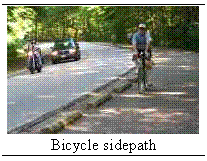
Many bicycle facility designers introduce hazards because they simply do not understand bicycle operation. Often these designers are landscape architects, not trained in roadway design. They produce paths that twist and wind around and under trees, with sight lines obscured by foliage and other obstacles. These paths may look pretty, but they are unsafe except at walking speed.
In the photo at right, if the cyclist brushes his front wheel against the curbstone, the wheel will be diverted to his left. This would dump him into the roadway to his right, possibly under the wheels of a passing car. In addition, at the curve in the background is a guard rail that has long bolts protruding towards the path. One of these could cause a nasty gash if brushed by a leg.
![Text Box: Crowded road [8]](../images/200709issue/article4-5.gif) Unfriendly Roads Unfriendly Roads
In a later section of this article, we show how a well-designed road that is adequate for the traffic carried is an excellent bicycle facility. In other words, every lane is a bike lane and every road is a bicycle facility. Unfortunately, some roads are poorly designed, badly maintained, or overcrowded with traffic. Inadequate roads are less comfortable and less safe than they should be for all users, including bicycle drivers.
The most frequent road defects involve poor repair (potholes, cracks, etc.) Because bicycles are balanced vehicles, often with hard, narrow tires, surface defects affect cyclists more than other users. Other problems include confusing situations that induce mistakes, non-responsive vehicle detectors at demand actuated traffic signals and wide intersections with inadequate time for traffic to clear when the light changes.
In some developing areas, road improvements lag development. This causes extreme congestion as the roads are used beyond their capacity. Heavy, high-speed traffic on what were once rural roads squeezes out cyclists and causes conflicts, particularly at intersections. You can read a discussion of this problem in the Triangle area of N. Carolina in Urban Traffic on Rural Roads by Steve Goodridge.
Hiding Behind Standards
Standards can not replace competence and knowledge by those who design bicycle facilities. This is especially critical when the standards have dangerous flaws such as the Guide for the Development of Bicycle Facilities [3]. Engineers are expected to do professional work as experts in their field [9]. However, we often see planners and engineers hide negligent bicycle facilities work behind weak standards.
Imagine if bridges were designed like bikelanes. Let's say a two-lane bridge is to have a load limit of 40 tons. The engineer, working according to official standards, would make the bridge strong enough to support one 40 ton truck, but not two trucks on the bridge at the same time or even one overloaded truck. After the bridge collapsed, everyone would blame the truck drivers for the accident. No professional engineering organizations would question this practice or correct the standards.
The bike lane that killed Dana Laird (see above) actually exceeded the minimum width of 12 feet for the combined width of bike lane and parking space (although not the "preferred" 14') specified in the Guide. Critical parts of the AASHTO bike lane standards are dangerously inadequate [10]. It may take a large legal judgment to make these standards safer.
Where there is not enough room to install bike lanes without adding explicit hazards (in addition to the intrinsic danger of separate facilities) then there is no excuse for installing bike lanes.
Professional Engineers are required to conform to a code of ethics: The National Society of Professional Engineers NSPE Code of Ethics for Engineers includes the following:
Engineers, in the fulfillment of their professional duties, shall:
[...]
2. Perform services only in areas of their competence.
Rigorous professional certification for bicycle planners and engineers is sorely lacking. Joining the Association of Pedestrian and Bicycle Professionals or taking a bicycle facilities design course from the Federal Highway Administration does not ensure competence about bicycling. We have suggestions for professional training in section 9 of this article.
If an engineer designed a bridge according to the methods often seen in bicycle facilities he would likely have his engineering license suspended or revoked for malpractice. At this time, we know of no engineer disciplined for designing dangerous bicycle facilities. The current state of public knowledge for bicycle matters is so poor that malpractice is normal and expected.
We should acknowledge that the AASHTO Guide, as badly flawed as it is about installing bike lanes next to parking and at intersection approaches, does at least specify minimums. Cyclists can and do cite the AASHTO Guide to block some of the worst proposals for substandard bike lanes.
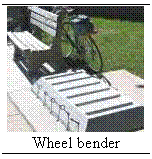 Bicycle Parking Bicycle Parking
The traditional schoolyard bike rack that holds a bike by its wheel was designed for children's bikes with cheap steel wheels. Most adult bicycles have lightweight aluminum wheels that can easily be damaged by these "wheel benders". Knowledgeable cyclists refuse to use them. The photo at right shows a concrete block with wheel slots. This is much worse than a schoolyard rack. The cyclist has instead hitched to a bench that supports his vehicle better.
Recommended Reading About Bicycle Facilities
Bike Lanes and Safety Research
Bike Lane Contrarian slideshow
Articles on Bicycle Facilities (John Forester's critiques)
A Realistic Look at Bicycle Facilities, Laws and Programs
Lessons of the Vassar Street Sidepaths
Wide Outside Lanes are Superior to Bike Lanes, Why segregation is bad
Bike Lane Stripes: Do they improve conditions for cycling?
Critique of FHWA Bike Lane Versus Wide Curb Lane Study--Faulty design and analysis plague this often-quoted study
Implications of Universal Access Principles for Bicycle-Specific Roadway Markings
Dilemmas of Bicycle Planning
Bikeway Activists in the Wrong Lane
Cycle path safety: A summary of research (British article)
Footnotes
[1] "Blue Bike Lanes for Greater Safety", article on the Portland, Oregon web site.
[2] Wayne Pein photo.
[3] Guide for the Development of Bicycle Facilities, American Association of State Highway and Transportation Officials, 1999
[4] Manual on Uniform Traffic Control Devices, Part 9 Traffic Controls for Bicycle Facilities.
[5] Robert Winters photo from Cambridge Civic Journal.
[6] The City of Chicago Bike Lane Design Guide.
[7] The illustration appears in a review by John Forester: Bicycle Facility Selection: A Comparison of Approaches by Michael King, Architect. Bikelane Design Guide by Chicago DOT
[8] Dan Burden photograph, www.pedbikeimages.org.
[9] Each state defines requirements for a Professional Engineers license required for certain public safety functions, such as designing buildings, roads and bridges. Portions of the Code of Ethics have been incorporated into state law. For example, the Ohio Administrative Code §4733-35-03(B) states: The Engineer or Surveyor shall undertake to perform assignments only when he and/or his consulting support are qualified by training and experience in the specific technical fields involved.
[10] For another critique of these standards, see AASHTO and Door Zone Bike Lanes.
© Copyright 2004-2006 Fred Oswald. Non Commercial distribution authorized.
Some materials may have been reproduced under fair use guidelines or with permission of the original author.
Close this article |

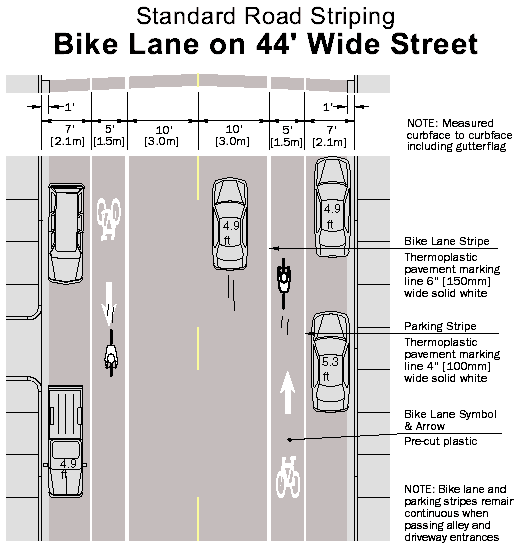



![Text Box: Crowded road [8]](../images/200709issue/article4-5.gif)
 Bicycle Parking
Bicycle Parking